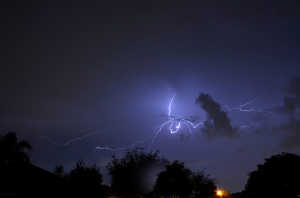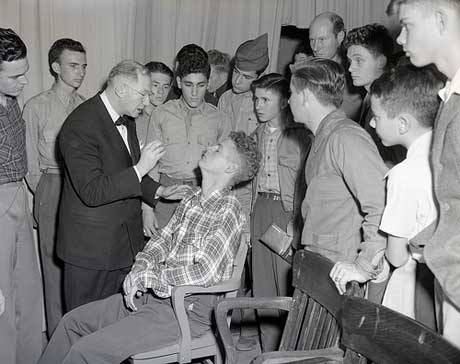
 Photo by Brett Levin Photography
Photo by Brett Levin PhotographyWHAT IS LIGHTNING
Lightning is a fierce occurrence in nature that involves a natural electrical discharge of a very short duration and of very high voltage. This discharge takes place between a cloud and the Earth’s surface. The typical lightning strike is composed of a series of several strokes and restrokes. Normally thunder is associated with this discharge as a result of the intense lightning flash heating the air around it. Lightning is also capable of producing X-rays.
Volcanic ash clouds and forest fires may also produce lightning. This is caused from the static charges in the air that are formed from the dust they create.
The energy that’s in a bolt of lightning is less than that in a liter of heating oil. Although that doesn’t seem like much energy, lightning is still hot enough to fuse silica sand in the ground and form glass. With those facts in mind it may surprise you to know that approximately 50% of people struck by lightning actually survive the strike. That’s some fair odds, although I wouldn’t want to test them.
LIGHTNING AND GEOGRAPHY
So let’s take a closer look at some of the statistics in different parts of the world.
Statistics show that the North American continent receives the most lightning strikes of any continent in the world. The United States receiving 20 million strikes a year and around the globe there are approximately 8 million lightning strikes per day. It’s said that from space you can see the strikes discharging all over the planet like a wonderful light show. I’d love to be able to see that!
Rwanda, Africa has the most lightning strikes per square mile of any other area of the globe. That is why it’s known as the lightning capital of the world.
People residing in Florida, U.S.A. are 34 times more likely to be struck by lightning than the average American. Between 2000 and 2009, 70 people in Florida were killed by lightning. But during that same time frame, there wasn’t a single person in Alaska, Hawaii, Delaware, New Hampshire, North Dakota, Oregon, Washington State or Washington, DC that was killed by lightning. That tells you a little bit of the best geological locations in order to avoid a lightning strike!
The Empire State Building is struck by lightning an average of 23 times a year. It was once struck 8 times within a 24 minute span.
SOME EFFECTS OF LIGHTNING
We’ve all heard the famous story of Benjamin Franklin flying his kite. Franklin did this by tying a key to a kite string and flying the kite during an electrical storm. But one misleading fact… He didn’t actually hold the kite string while flying the kite. He tied the string to a post and observed the results from a safe distance. One little known fact is that a French experimenter had tried this antic a few weeks earlier than Franklin. Following Franklin’s experiment, there were actually several fatalities of folks trying to replicate his actions.
Elm and Oak trees are the trees that are most frequently struck by lightning. When hit, the bark blows off of them. This is because the heat from the strike causes the sap to boil violently under pressure and it then explodes.
If lightning were to strike near a compass, the needle would spin wildly due to the electromagnetic field that is generated. So if you’re hiking and you notice your compass going crazy, then you may want to head for cover, it’s possible a bolt may be heading your way.
And of course we have to conclude this with the technical name for the fear of lightning. That would be astraphobia. Lightning is a wonderful and beautiful thing that nature creates, but you have to respect it and use good sense when in a situation that may produce it.



How do you collect these information..Really
It all looks new to me..
Most of my information comes from either research or simply my views of things that I ponder in my head. I’m notorious for taking the simplest things and tearing them apart in my mind, I just like to share my personal views on things with my readers. I believe it offers a fresh perspective on the topics we normally take for granted, I hope you are enjoying it, it is my passion. 😀
Thanks for sharing Robert, Currently in modern time everyone do maximum use of natural resources. We must need to save it because future source is decreasing day by day.
It’s true, the planets natural resources are depleting each and every day. I think a lot of it is done without the best intentions in mind. The planet can hardly keep up and one day all it’s goodies will be used up sadly.
I”m inquiring about the idea of magnetic compasses spinning and going wild before lightning strikes. Has any one here observed such a phenomenon? If so just what is seen? fast spinning in one direction or “random” flailing about? I’m a physics student who builds demonstrations and would like to understand this phenomenon in hope that I might be able to reproduce it artificially and explain it using Maxwell’s equations. I’m going on the hunch that a “free to spin” magnet like a compass will spin in a certain direction when an electric field is changing along the axis of the spinning. Electric fields are DEFINITELY changing just before lightning strikes. ( I have no intention of walking about outside during a thunderstorm holding a compass, too Darwinian for me. I wonder if I could get a freshman to do it? hmmm…) Thanks.
Well Rustin I have to say that is a very interesting experiment you wish to produce. I have not researched how lightning and magnetism may bond with one another in relation to a compass. But considering how the Earth is loaded with magnetic fields and lightning is a compilation of charged particles, it makes sense that if you were in a highly active electrical storm there could potentially be enough energy to distort the magnetic fields around a compass.
But on another note, I would consider that the Earth’s magnetic pull would be much stronger than what an electrical storm could produce. Therefore it seems that a compass would stay focused on the Earth’s magnetic fields. But I do know this phenomena you speak of has been known to happen. But I wouldn’t even know where to begin in replicating that as an experiment without extensive research on the subject.
Sorry I couldn’t be of more help.
First, thanx for replying. I talked with some professors at my university and I got an explanation that I can accept as reasonable. When there is an INCREASE in electrostatic field (like the time before lightning is about to strike) a magnetic field is created in the direction of that CHANGE in electrostatic field. Assuming the buildup is not steady, you will get periods where a compass will want to align with the buildup in electric field and other times when it will prefer to align with the earth’s, depending on what is stronger at that time. It could easily go back and forth any number of times until the changing stops (after lightning strikes) or if the electric field dissipates without any lightning bolts. Apparently, based on this explanation, a compass held by an observer could take on almost any motion during the buildup since the change in electric field could have any vector. 🙂 (I hope I never see it personally)
Thank you Rustin for reporting your findings on this. That’s just about as good an explanation as you would find anywhere and makes total sense. I’m surprised to hear that the electrostatic fields produced by lightning is strong enough to fight with the Earth’s electromagnetic fields. But we have to remember just how powerful some of those bolts of lightning are, so I can’t argue that it’s very possible.
I’m assuming that the person holding the compass would need to be a little too close for comfort when the electrical storm was building in order to witness this event…lol